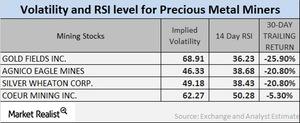What Are Miners’ Volatility and RSI Levels?
Precious-metal-based funds such as the ProShares Ultra Silver (AGQ) and the Direxion Daily Gold Miners (NUGT) have seen a revival in their price during the last month.
Jan. 17 2017, Updated 5:36 p.m. ET

Precious metal funds
As we saw in the previous part of this series, many of the fluctuations in precious metals resulted from speculation about the Fed’s interest rate stance. Now, let’s take a look at the fundamentals of South African precious metal miners.
Precious-metal-based funds such as the ProShares Ultra Silver (AGQ) and the Direxion Daily Gold Miners (NUGT) have seen a revival in their price during the last month. Mining stocks often show more volatility than metals themselves.
Next, let’s look at the implied volatilities of large mining stocks and their RSI (relative strength index) levels in the wake of the carnage of precious metal prices. We’ll look at Sibanye Gold (SBGL), Gold Fields (GFI), Agnico Eagle Mines (AEM), and Pan American Silver (PAAS).
Implied volatility
Call implied volatility takes into account the changes in an asset’s price due to variations in the price of its call option. During times of global and economic turbulence, volatility is higher than in a stagnant economy.
The volatilities of Sibanye, Gold Fields, Agnico Eagle Mines, and Pan American were 72.1%, 65.1%, 46.5%, and 53.3%, respectively, on January 11, 2017.
RSI levels
The RSI levels for each of these four mining giants rose due to their rising share prices. Sibanye, Gold Fields, Agnico Eagle Mines, and Pan American had RSI levels of 51.4, 54.6, 59.4, and 58.8, respectively.
The trailing-30-day returns of most mining companies are positive due to precious metals’ diminishing safe-haven appeal. These four have a 30-day trailing gain of 9.9%, 13.5%, 15.1%, and 2.1%, respectively.
